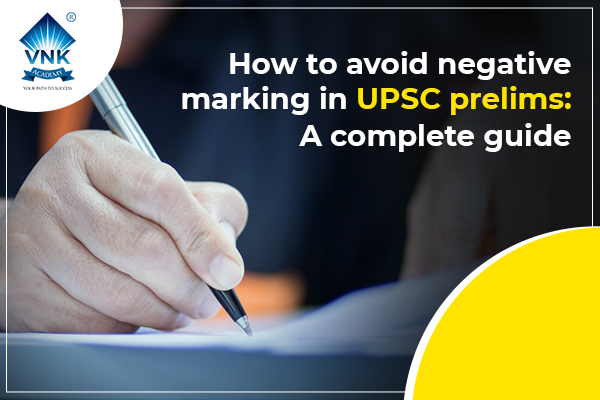In 2007, negative marks were introduced in the UPSC Prelims. Negative marking has remained in place even after the exam pattern was changed.
Negative marking is something that every UPSC candidate is concerned about. To do well in the UPSC Prelims, we must first comprehend the UPSC Prelims marks distribution. Before taking the Prelims, aspirants are frequently given a long list of Dos and Don’ts about the number of attempts at the topic selection and avoid negative marking.
For this post, we will look at how questions are graded and how to improve your Civil Services Exam score.
The UPSC changed its marking pattern to eliminate the consequences of guessing in the Civil Services Exam. Below are a few tips and tricks suggested by VNK Academy, the best Civil Service Academy in Kerala.
Top Tips on Improving your Civil Service Exam Score
• First, complete all of the questions you are certain of the answers to.
• Next, concentrate on the questions where you can eliminate two incorrect answers. In this manner, your chances of finding the correct answer to each of these questions are 50%.
• Assume you know the correct answer to a question is either (a) or (b). If your thinking leans toward (a), softly mark a ‘1’ next to it using a pencil (a). Also, put a ‘2’ next to (b). If you think you’re spending too much time thinking about this question, skip it after marking ‘1’ and ‘2.’
• Finally, disregard any questions you have no idea what the correct answer is.
• Now go back to the questions where you put a ‘1’ or a ‘2’ next to them. If you don’t have enough time, mark the final response as the option next to the one you marked with a ‘1’. Don’t forget to delete the number ‘2’.
• Think about and analyze your answer choice if you have time before marking it. Remember, you’re not making a random guess here; instead, you’re taking a calculated risk.
• Candidates should also remember that they do not need to worry or lose confidence if confronted with difficult questions early in the paper. They should approach those questions with anticipation. Every year, a few difficult questions appear, and the sequence in which they appear on the paper varies between sets.
• Despite knowing the correct answers, incorrect bubbles are blacked due to ignorance and stress, and it is assumed that the correct response was marked. That is something you should avoid.
• Avoid the guesswork, and don’t try any responses about which you aren’t sure. If you’re doubtful about the answers, don’t attempt the questions.
Few other things to bear in mind.
• Make sure you mark all of your answers correctly. Make certain that any pencil marks are fully erased.
• You will still receive negative marks for bad responses if you mark two choices, one of which is the correct choice.
• In the UPSC Prelims, you will not be penalized if you do not mark any answers.
Conclusion
Concludingly, The Union Public Service Commission’s (UPSC) Preliminary Examination for the Civil Services Exam is the country’s most desired exam, with over seven lakh students taking it annually. Multiple-Choice Questions (MCQs) are drawn from a wide range of curricula, which greatly expands the length and depth of the topics/subjects. As a result, it becomes difficult for pupils to be well-versed in all subjects. Due to the natural mounting pressure’ phenomenon, an applicant should not lose his or her cool in the examination hall. He or she should attentively study the question and instructions, such as “choose the correct or incorrect statement.”
There is no penalty for leaving a question unanswered, so leave it blank if you are unsure about your answer. When a student does not have enough information regarding the topic on the exam, the art of eliminating possibilities can help them locate the solution. And to know more about this, you can visit VNK Academy, the best civil service academy in Kerala.


